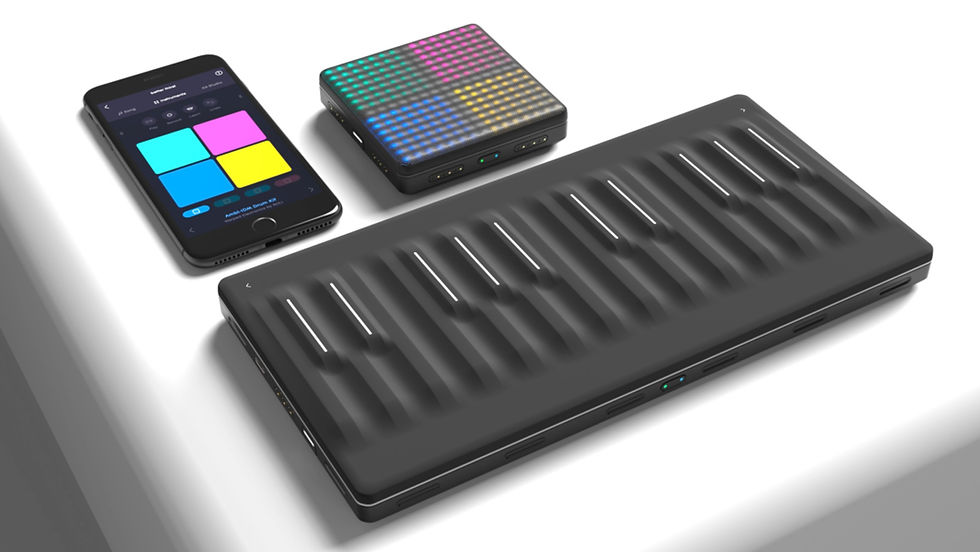Midi controllers are devices that can be used to trigger virtual instruments. They help bring an element of live performance and feel to your productions. They are invaluable for home studios and live performances alike. Midi controllers come in so many different shapes and sizes. Everyone has different needs, and there is a plethora of choices that is bound to fit with everyone's need. In this post I will try to shed some light on some of the types of controllers out there, and hopefully give you some sort of clarity when you're going to pick up one for yourself.
1.Classic keyboard/piano controllers:
Keyboard controllers are controllers that are modelled after pianos. They have the same key setup as grand pianos. They are great for someone who is already proficient at playing a piano or keyboard.

They come in various sizes and key counts. It can vary from one octave all the way to 7
octaves.

The smaller ones come in very handy when you're not really proficient in playing the piano and just want to get simple melodies out.
The larger ones are built more for piano enthusiasts who want to get the real feel of a piano. They sometimes come with weighted keys too to give you that feedback you get in acoustic pianos. You can also get sustain pedals that attach to them.

Most of the pianos come with velocity sensitive keys, but there are many that don't. This is something you need to watch out for when you're looking to buy one, especially because velocity sensitivity provides you with the some real feel when you're playing.
Here are some options to consider:
2. Pad based controllers:
Pad based controllers consist of a flat surface with pressure sensitive pads. They are usually in a grid format range from a small grid of 4-8 pads to as big as 64 pads in some cases. These pads can be pre programmed from your software to fire off samples that you have setup.

They can be programmed to be velocity sensitive and some of them have an after-touch feature too where you can have an extra degree of articulation when you lift off the pads. This can be a really cool touch for live performances.
I would suggest stick the big brands like Akai. You will not be disappointed with the quality of the pads and they usually last much longer which is what you're looking for in a MIDI controller because it becomes like
your instrument as you keep using them.

Here are some options to consider:
3.Hybrid midi controllers:

Hybrid controllers are also very good value for money as they can come with so many features. A great choice for someone who is confused about what Midi controller to buy as you can get a feel for a bunch of applications. You can then narrow down which feature suits you the most and build your arsenal of Midi controllers while plowing through all your savings. Welcome to the music production life!

Here are some options to consider:
4. Control Surfaces:

Control surfaces are Midi controllers that are fully integrated with your software. All the buttons and features on them have been pre wired to control different aspects of your digital audio workstation (Ableton Live, Cubase, Fl Studio, etc). They are a great tool if you don't want to think about drivers or programming. Just plug them in, fire up your software and you're good to go. They're very reliable too for this reason.
The main pitfall is that they can sometimes be limiting for more advanced users as you can't really customize the MIDI map. But saying that, they have been carefully designed by a teams of experts and musicians so you can expect a pretty smooth workflow.

5. Utility controllers:

These are supplementary midi controllers usually used by engineers or DJs to trigger certain effects and have more control over their interface. They can be useful for musicians too depending on the situation. You can use them to set levels for a live mix, mute certain tracks during a performance, add certain sound effects.
Utility controllers can also be used to control lights and projection setups on stage. They're great for visual effects engineers who want to get performative with their setup. They come with a bunch of knobs and fader and buttons that are fully customizable.

6.Boutique controllers:
There are several other cutting edge controllers out there that offer very specific feature sets that make them unique. They're not usually an upcoming producer's first choice. They're more for the audio geeks out there.
They can be roughly modelled after acoustic instruments and then fully Frankensteined into something weird yet powerful like the Roli keyboards and blocks you see above.
The Expressive E is another example of a niche MIDI controller with an ultra sensitive pedal mechanism that has interesting articulation setups that can be used to either trigger samples or effects.
There are also amazing modular midi controllers where you get a circuit board and components which can arrange and build however you feel fit. You are basically designing and conjuring your own midi controller at this point.
PS. If you're an independent artist and want to submit your music to spotify playlisters and youtube networks for a chance to be featured, go ahead and hit the button below:






Comments